Whistory:
This complex is made up of two sets of three whistle stamps, escargots and tube shaped whistles stamped Horstmann, Arkay and A G Spaulding. Whereas the connection between the whistles themselves can be verified, the history of who made them and what dates is obscure. As for dating, suffice it to say that circa 1900 to 1925 would span all three stamps and whistles.
Rather than wait for historical discovery of manufacturing, it was thought to go ahead and publish what is known about the whistles themselves. Here is presented the Horstmann/Arkay/Spaulding complex in tube and escargot shaped whistles with variations included.
The best known of the complex are the Horstmann stamped whistles. Therefore, dating this company would be a starting point, then adding in the construction of both types of whistles follows.
Reportedly Horstmann house was founded ( in 1815 ) by William H. Horstmann and was a USA based company till 1935’.
They changed their stamp on their products to Horstmann Philadelphia in 1893 ( previously changing by variations of partners and states etc.) Therefore this helps in dating these whistles and we will be examining between the dates 1893 to 1935.
Interestingly enough, Horstmann was primarily a military clothing supply company that manufactured uniforms. A couple quotes would indicate that they were not metal workers per se —
‘Horstmann did not manufacture buttons, but was a large military outfitter. The Scovill Manufacturing Company of Waterbury, Connecticut manufactured many of Horstmann’s buttons’
‘Every part of the sword and trappings, with the exception of the blade, is made on the premises. The blades are almost all imported from the ancient German sword-blade emporium of Solingen’
‘They have made several important inventions, as we have elsewhere mentioned, and their list of manufactures embraces a wide circle of fabrics of silk, silk and worsted, mohair, cotton, gold and silver thread, including some descriptions not made elsewhere in this country, besides every variety of military trimmings, not excepting swords, drums, and metal ornaments.’ –
Posted timeline of dates through history.
W. H. HORSTMANN / PHILA. 1820-1850
W. H. HORSTMANN / NEW YORK 1820-1837
W. H. HORSTMANN & SONS 1843-1863
W. H. HORSTMANN & CO. / PHILA. 1864-1866
W. H. HORSTMANN & CO. / NEW YORK 1837-1847
HORSTMANN BROS & CO. / PHILA 1859-1863
HORSTMANN BROS & CO. / NEW YORK 1850-1852
HORSTMANN BROS & ALLIEN 1852-1877
HORSTMANN BROS & DRUCKER 1844-1850
HORSTMANN / PHILADELPHIA 1893-1935
The highlighted line is for dating known stamps on Horstmann whistles in the Whistle Gallery reference collection. The design of the tines inside the tube shaped whistles match ones from the UK dated 1907 found on page 58 of more whistles ( Gilchrist 2005 ) with the tine angled back ( note figure one ) towards the partition wall.
There does not appear to be tines used in the UK until Hudson’s 435 patent of 1885 ( UK ) – innovated due to the lack of tines allowing the disc to come loose inside the whistles.
Figure ONE below :
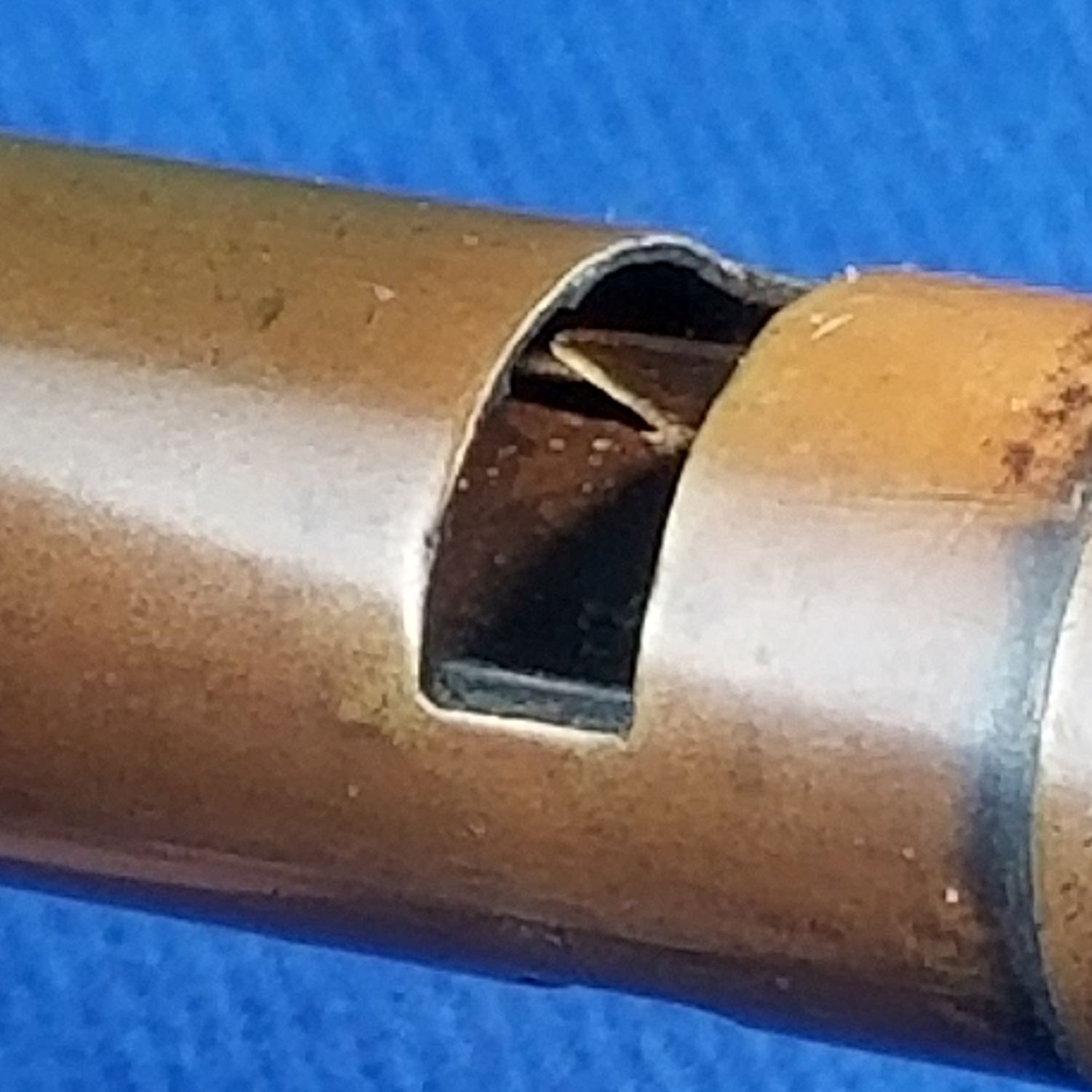
It would seem that the time line is not conclusive. Therefore we are dating these whistles 1907 to 1935 matching to the last line.
Various stamps will be highlighted as possibly made by the William Horstmann manufacturing company as follows:
Horstmann Phila.( spelled with two Ns, smaller A after Phil )
Wm H. Horstmann & Co. Phila. Pa US Army
Made in USA
Arkay
Spaulding
William Horstmann Co. specialized in military equipment, dating from 1815, primarily woven materials. They eventually spread out from clothing to manufacturing of swords ( except for the blades ) and other equipment which gave them the capability of making whistles. The ‘Glasgow’ named type of whistle was patented in the UK by Joseph Hudson in 1891 and the escargot shaped whistle stamped Horstmann follows that type of construction. Likewise, the tube shaped whistle type construction was patented in 1885 also by Hudson with tines used to attach the separating wall inside to the side walls.
As for Arkay, it is possible that whistles stamped ARKAY ( AR-KAY ) may stand for Max Kaneff and William Raburn who in 1922 started the ARKAY Packaging Company. William Rayburn was Ukranian and the backwards R and forward K formed a Ukrainian letter ( ZH ) for their business logo ( also used on whistle stamps – i.e. escargots ).
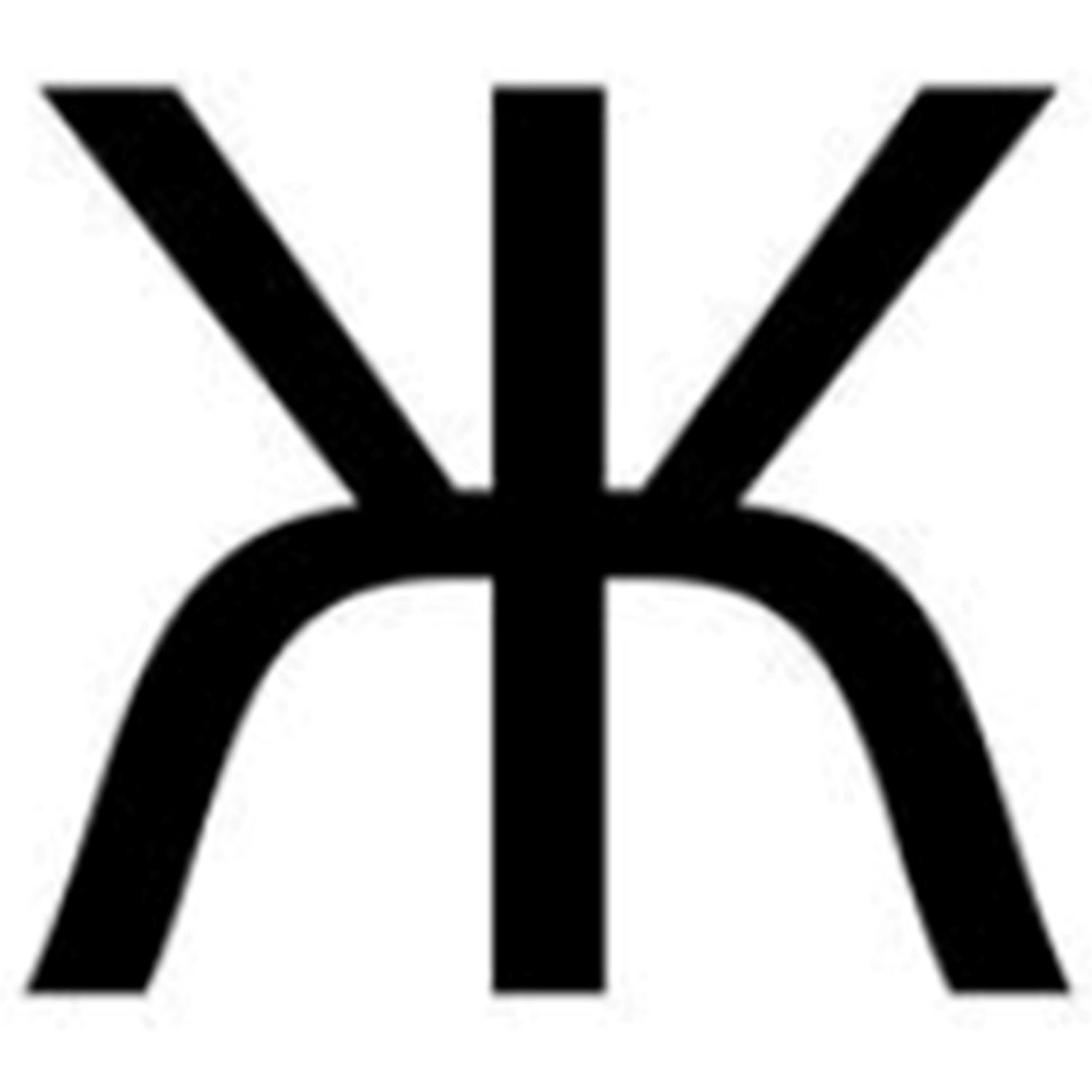
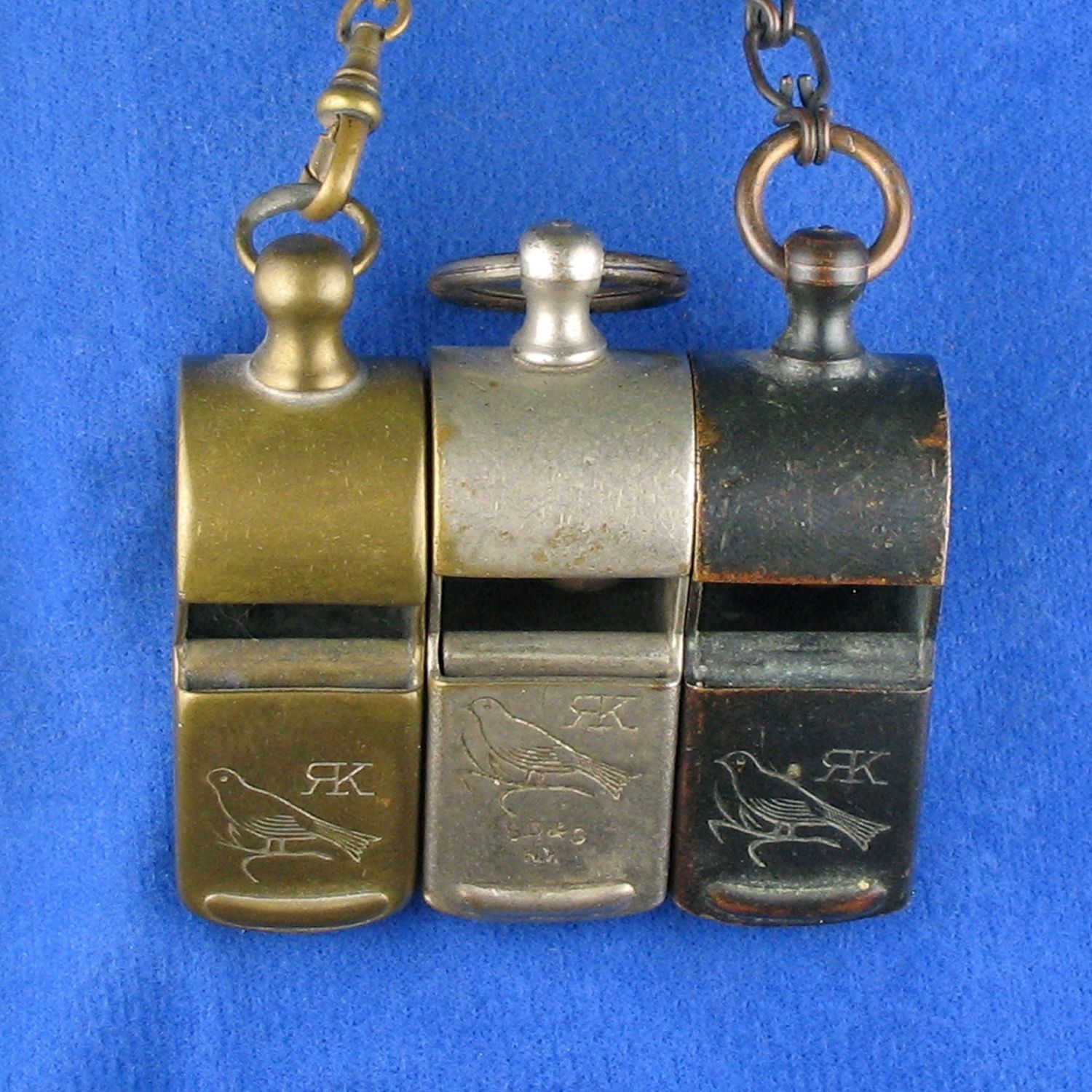
Apparently he left the partnership in 1929 to Max Kaneff. We find long, tube shaped whistles made to the same specifications as Horstmann stamped whistles with ARKAY stamped on the top caps. We find RK ( with a backwards R and forward K ) on escargots only, but along with a bird stamp ( ? )
The A. G. Spaulding Sporting Goods Company started in 1876.
Spaulding stamps on whistles were used for decades ( long after the tube shaped whistle ) switching to escargots as a more ‘sport’ like whistle, perhaps spanning decades. However unlike tube shaped Horstmann & Arkay whistles, escargot whistles known indicate that Spaulding contracted with different whistle manufacturers.
Dating whistles more accurately in this triplex proves difficult. Advertisements and/or catalogs indicating any of the three are scanty. How are they related then ??
There are some clear distinctions from other manufacturing techniques amongst this complex including the following:
Tube shaped whistles
Sharp flatter cap edges
Off center punched top ring
Length
Tines
Escargots
wider knop
raised centerline tongue
Did Horstmann manufacture whistles? With such a large facility, they had the capability. However, it is not clear if they actually manufactured to ‘farmed it out’. Yet if not, who did manufacture them? For a certainty, they display distinctions in many ways.
WHISTOLOGY:
— stamp changes
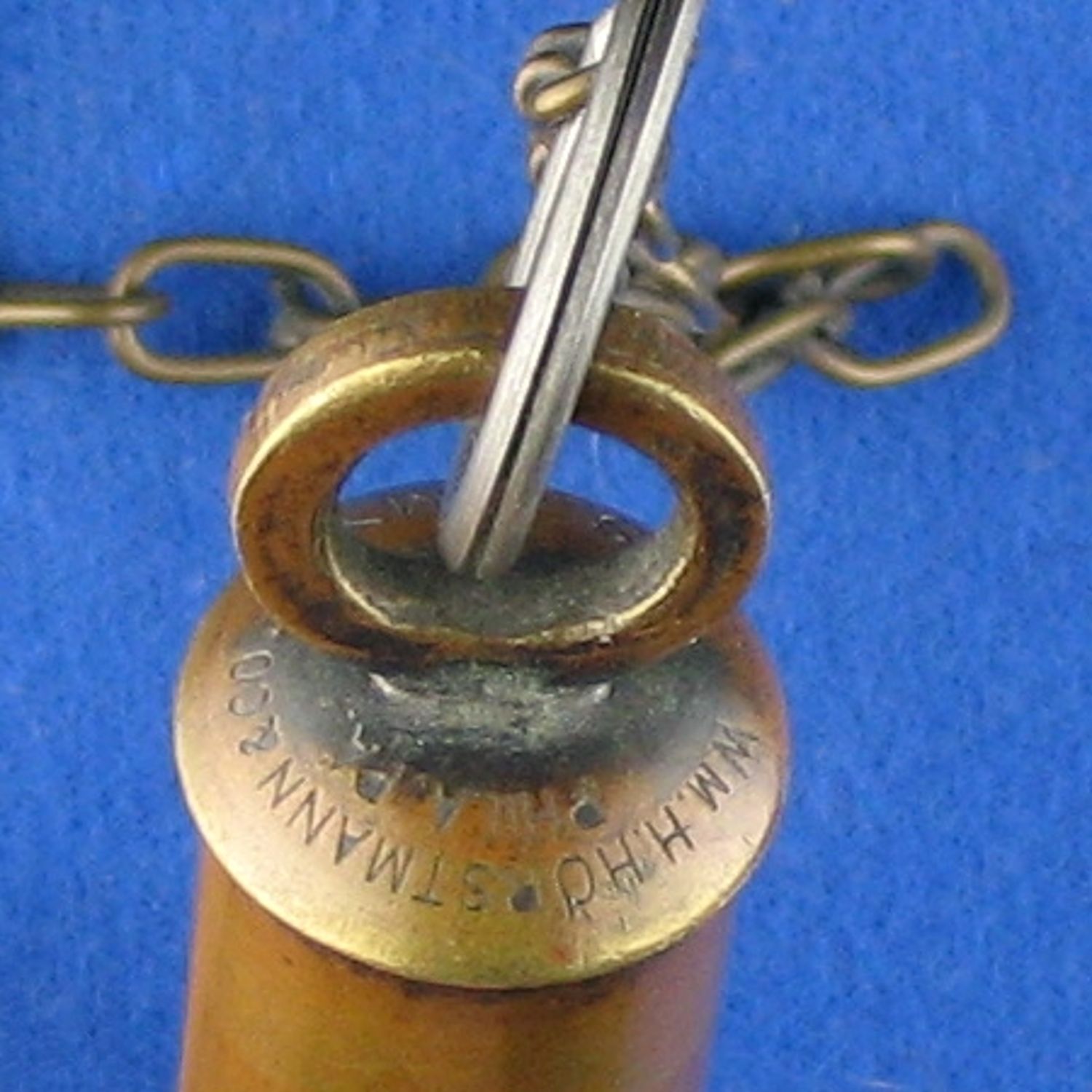
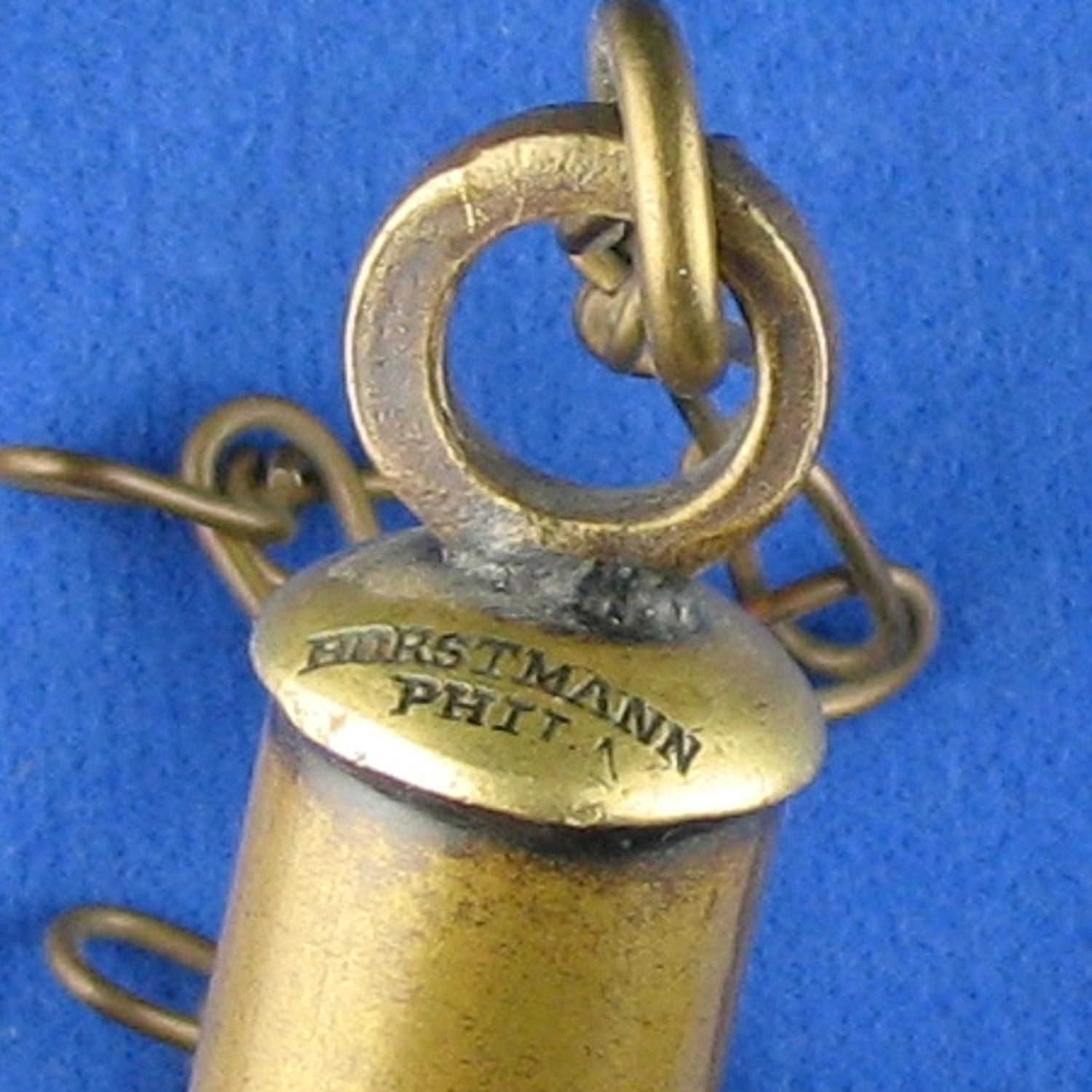
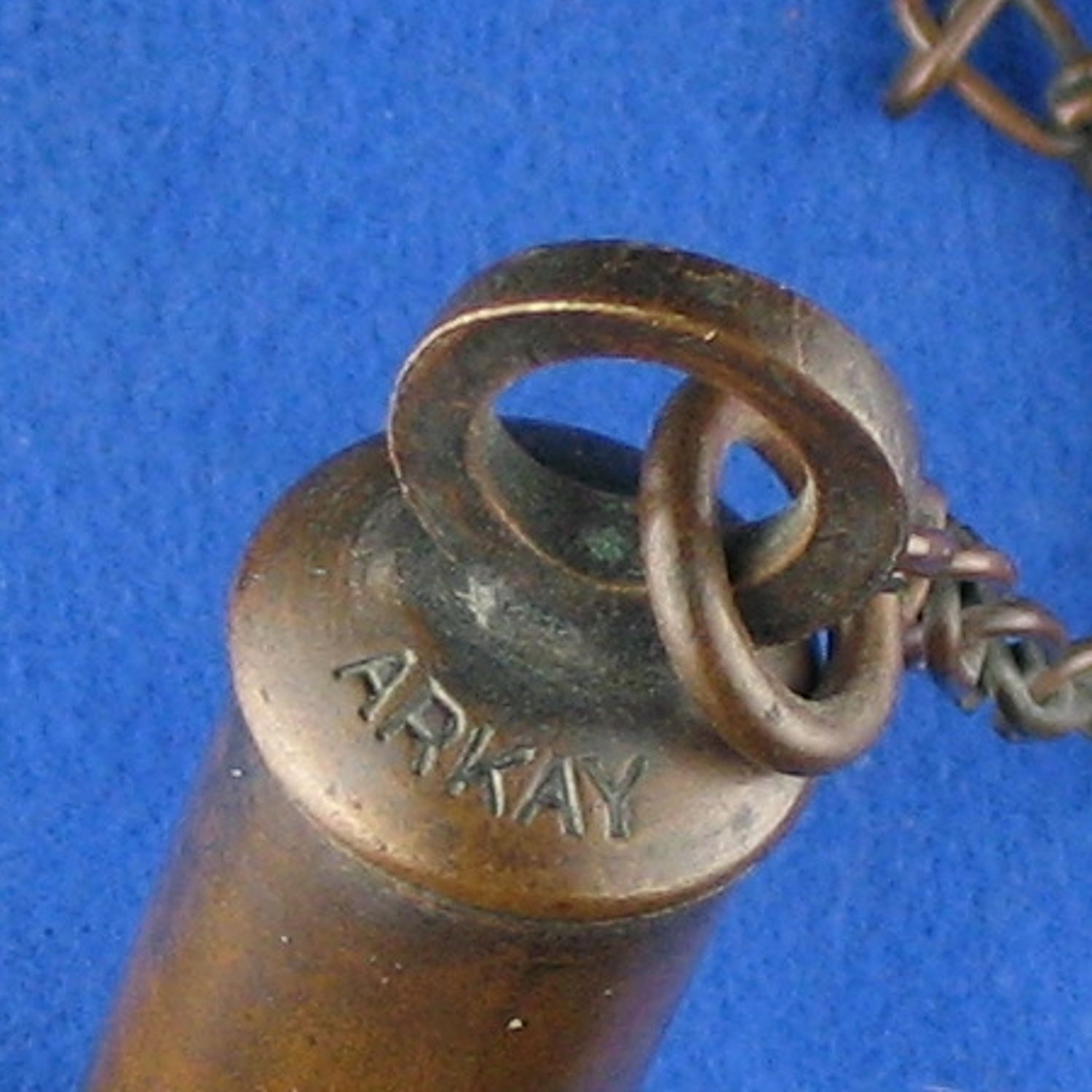
GSWs ( general service whistles )
Some manufacturing characteristics as follows:
The body seams were not centered between the windows, but ran varied ( at least at first ). The top rings are crude cut and concave to an extent, these were made in two pieces, and soldered on to the cap which could easily come loose.
The length is 91 mm ( 84 mm for the army model ) which is slightly longer than common.
Although brass or plated brass was the norm of the day notably Arkay whistles can be found made with copper.
The loops were punched ‘off center’ with one side wider than the other.
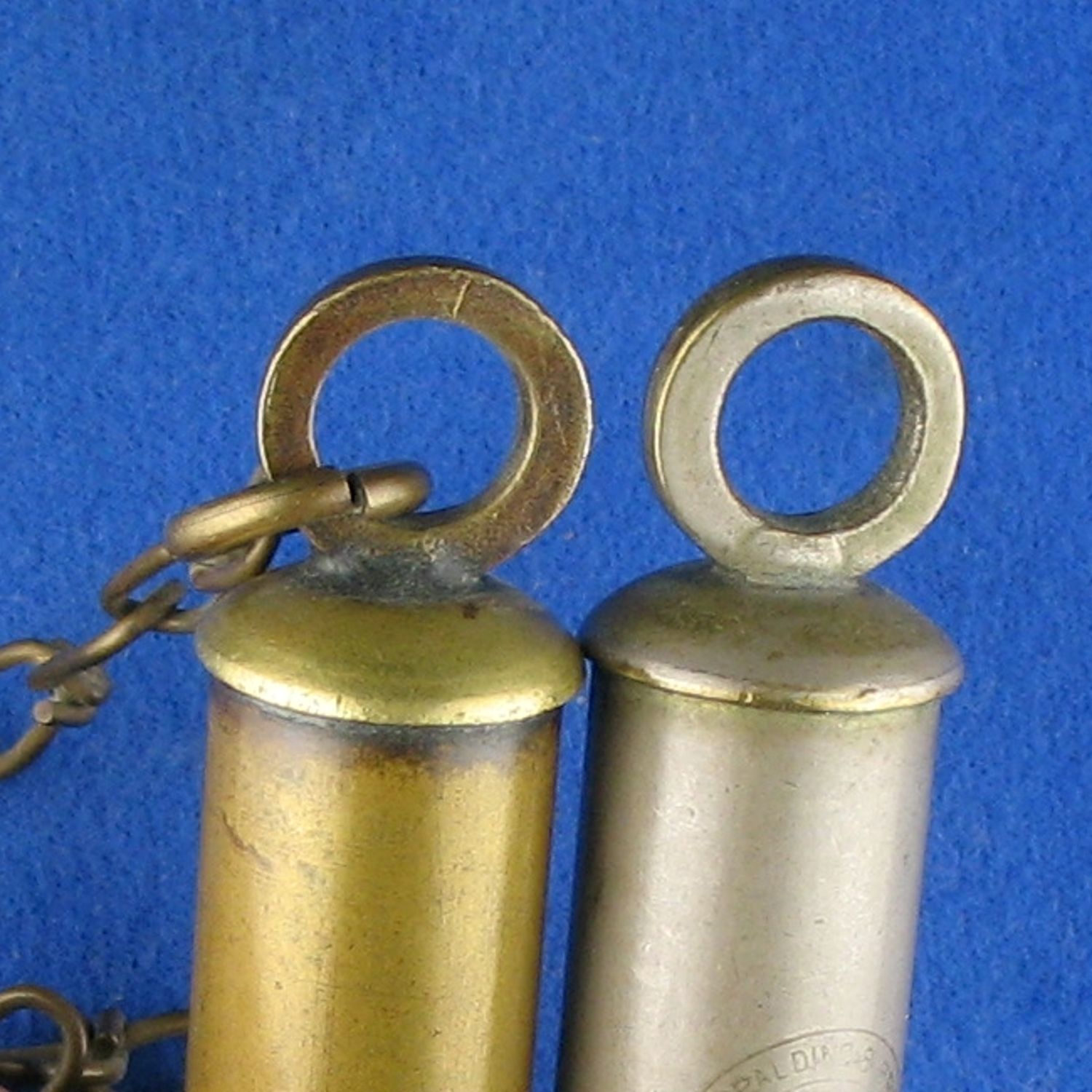
Another identifying mark when not stamped is the sharp edge and shallow top cap unique to this complex.
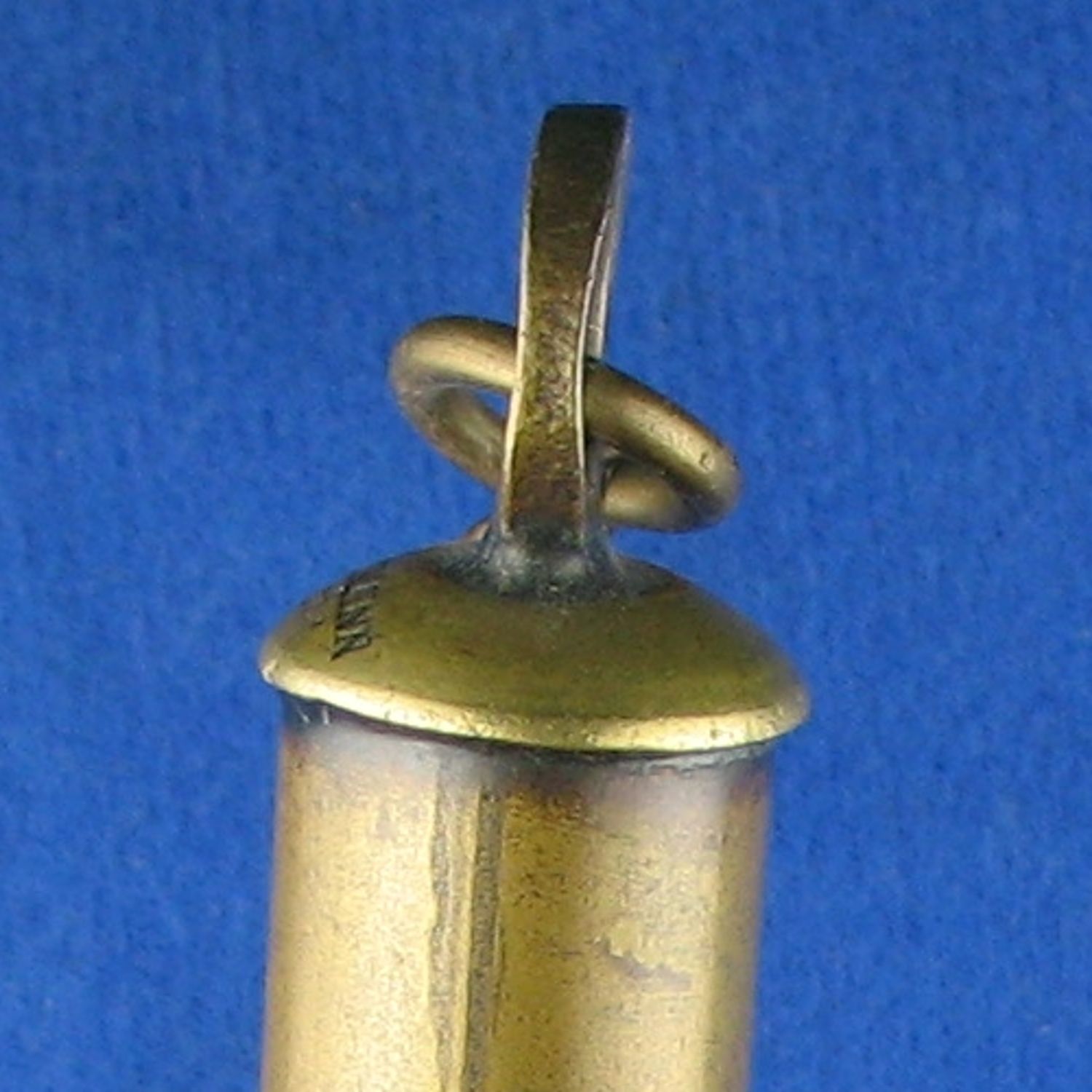
The earliest tines straddled the partition as shown above in figure ONE traveling away from the mouthpiece. Notably a) change would occur unique to this complex. The two tines would be turned the opposite direction ( reversed ) towards the mouthpiece. This was opposite of what occurred in the UK.
This has not been seen on Horstmann or Arkay stamped whistles. Only on Spaulding and also an unstamped later dated whistle generically stamped made in usa.

The whistle on the right is Arkay, left is not a Horstmann, note the loops are identical. The copper manufacturing includes the chain and all.
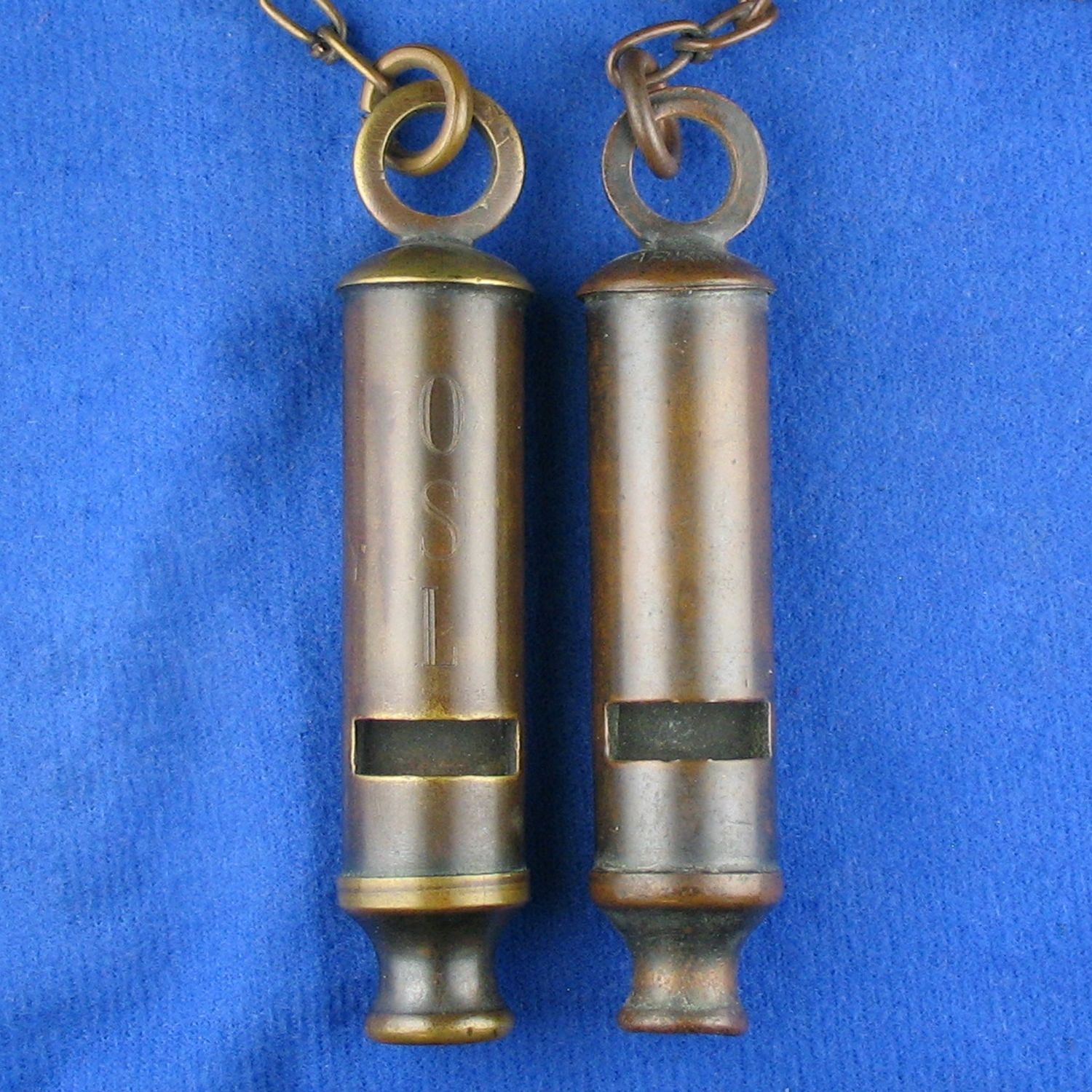
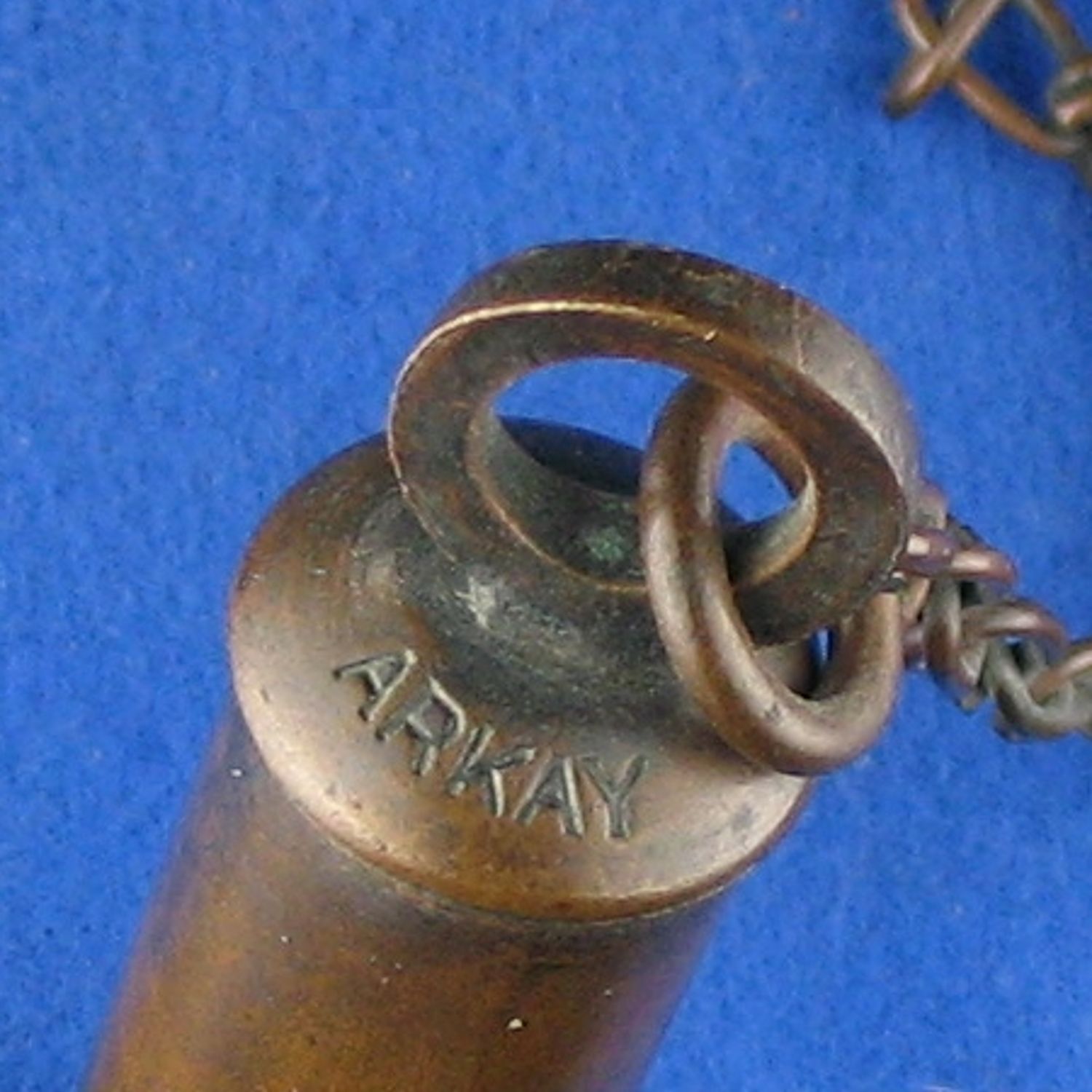
Lastly the Spaulding group
The two on the right have the forward pointing ( towards the mouthpiece ) tines. The more often seen model of Spaulding (left) whistle has the tines pointing to the top ( away from the mouthpiece ) matching Horstmann and Arkay.
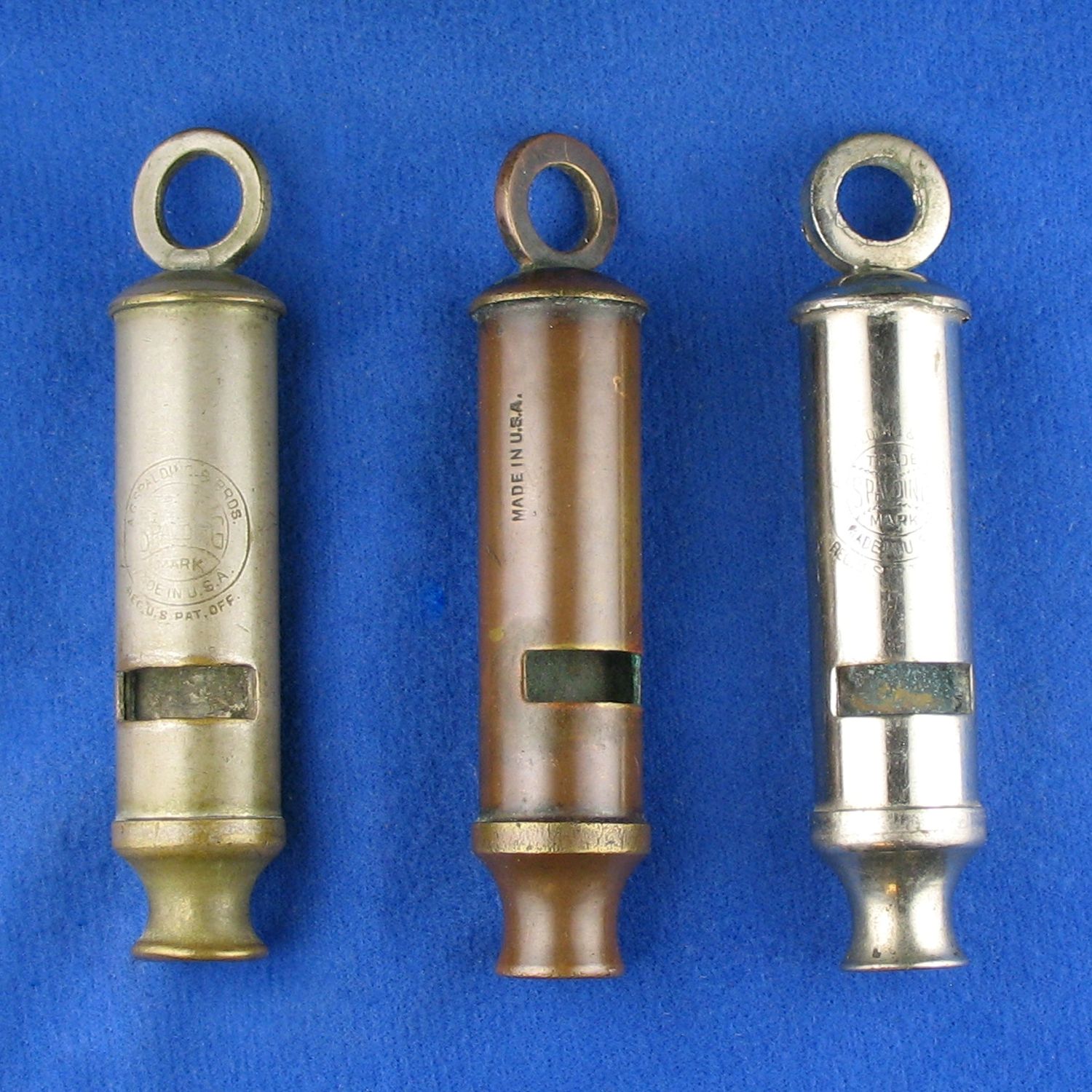
Lastly a group comparison of Horstmann/Arkay/Spaulding
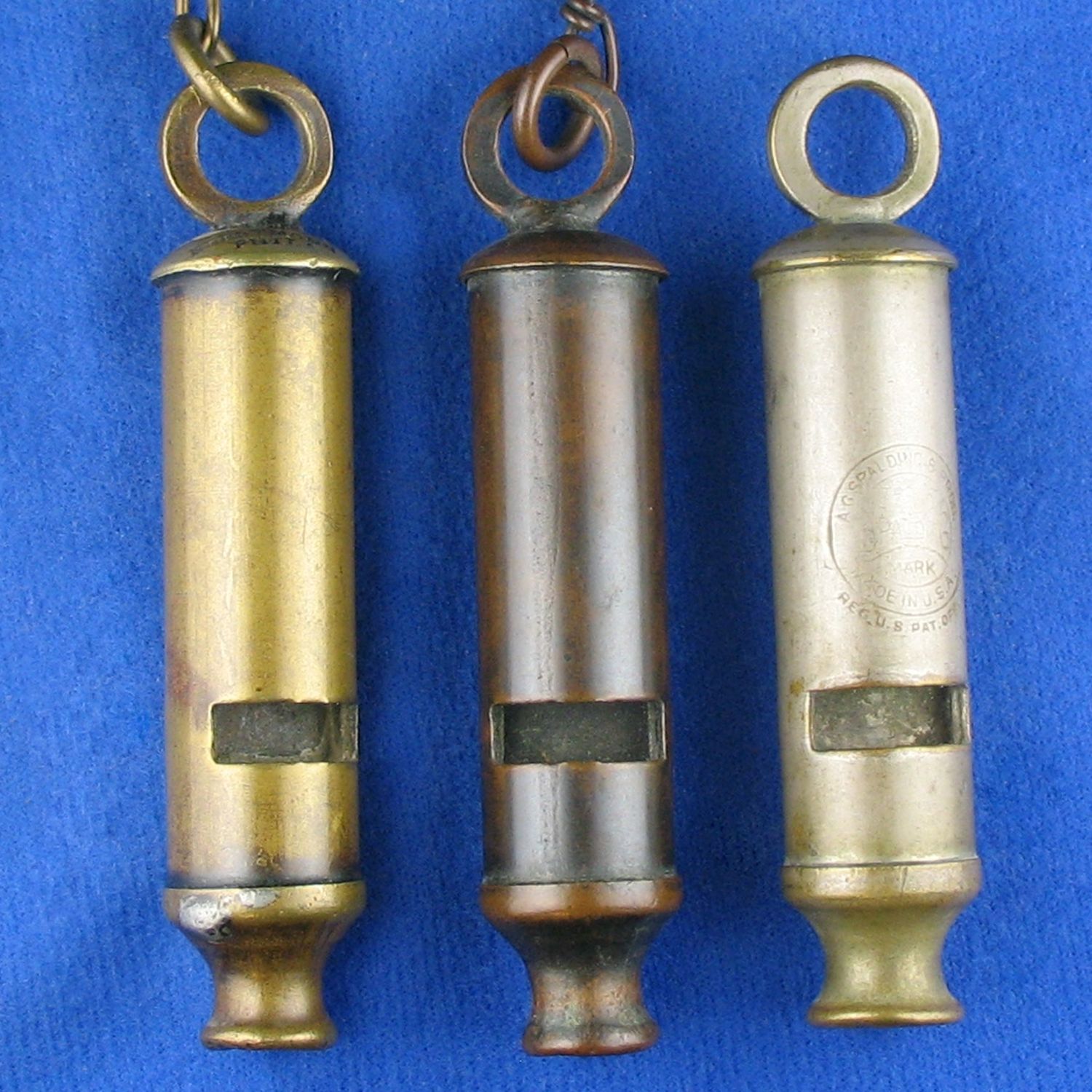
ESCARGOTS:
Most often ( but not always ), the knop is wider at the top. Windows can vary in openings. However the tooth grips always match and can be a very helpful in identifying groups of escargots. The left whistle is early for Horstmann. There is copper and brass used in the construction which is rare. All others found have been brass. It is also very rare to find one with a flat tongue like this one.
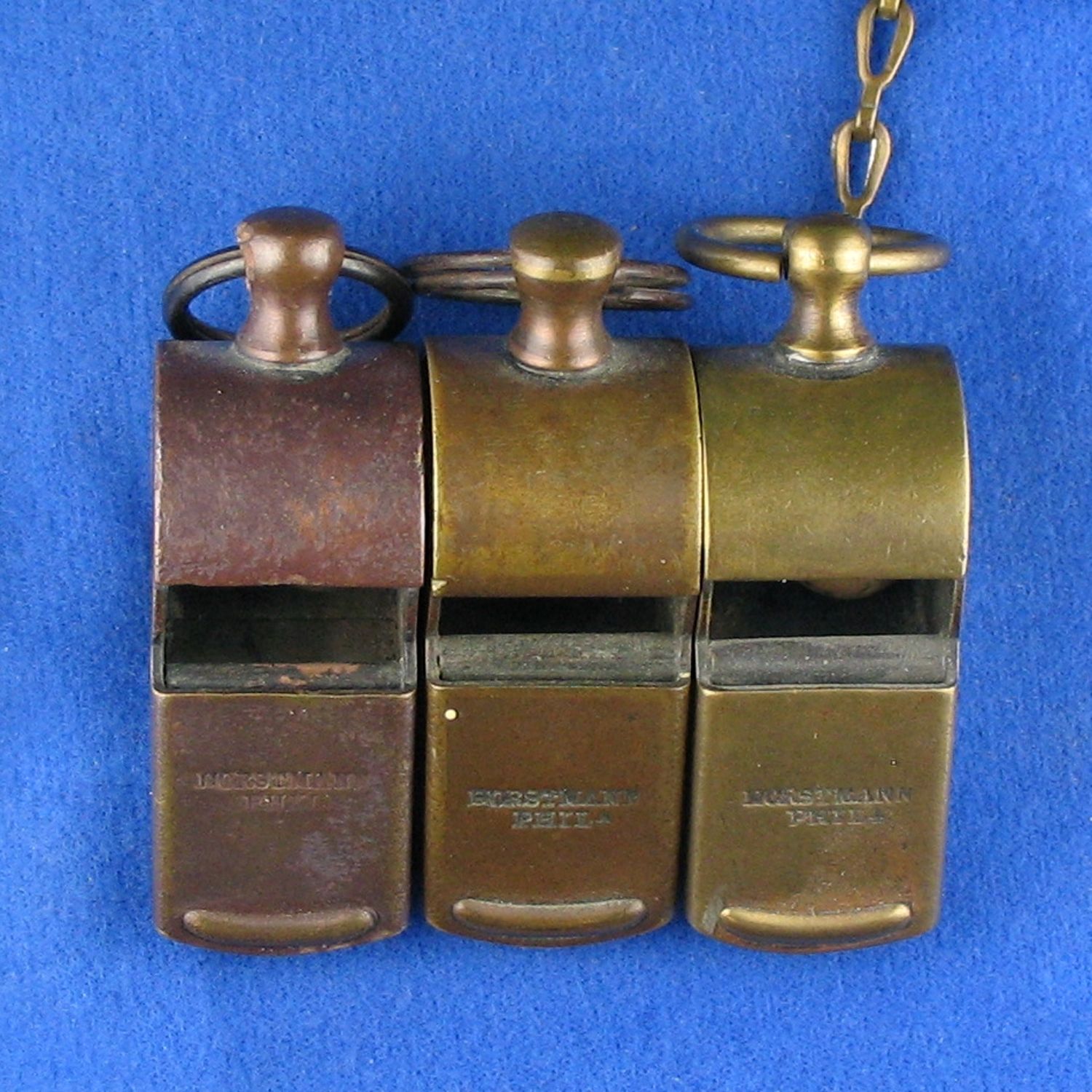
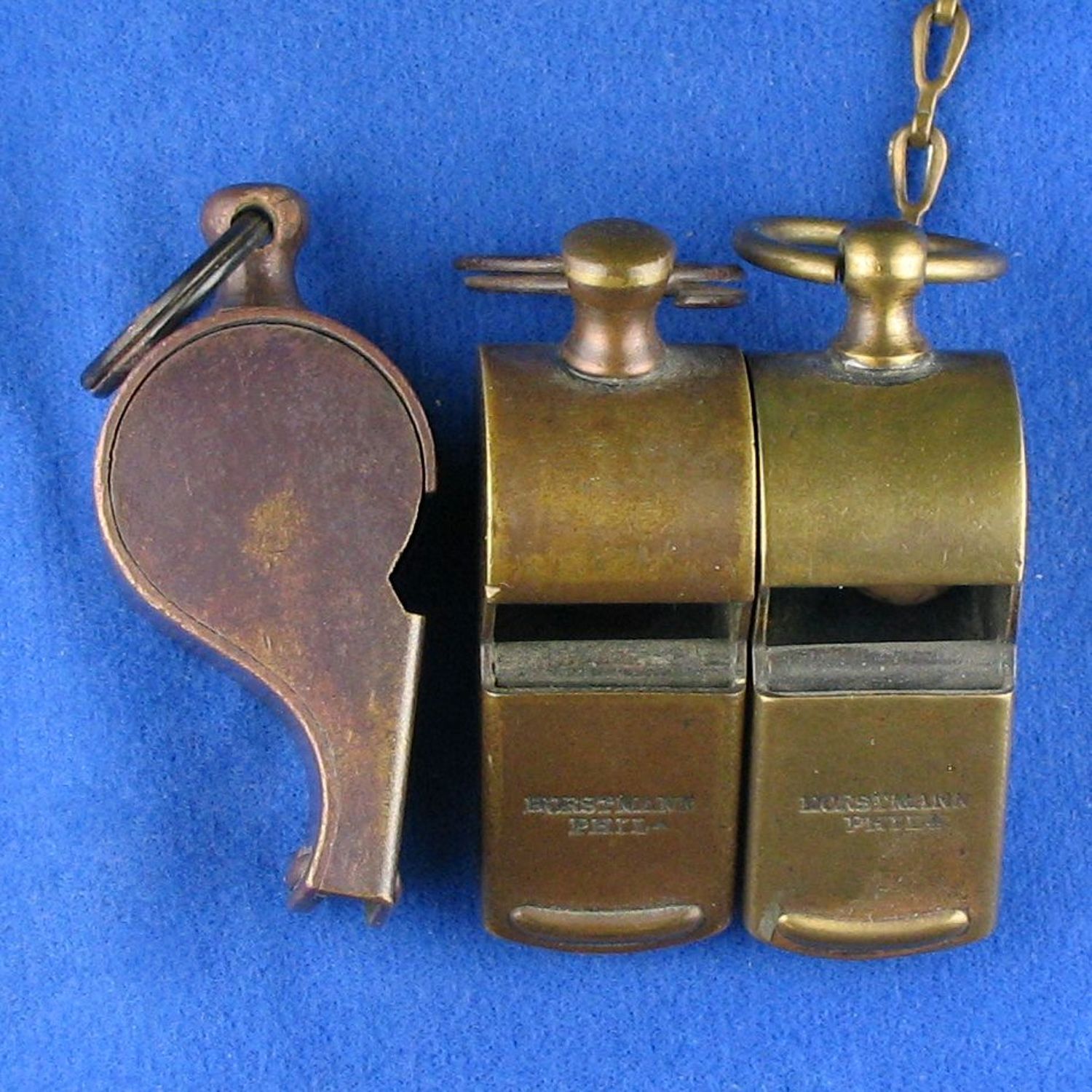
In identifying these, the tongues are shaped as follows in all three stamped escargots. We note the curved center. Gilchrist in More Whistles page 23 dates this feature to early 1920s in the UK.
Perhaps it was used earlier in the USA. The tooth grips top and bottom match
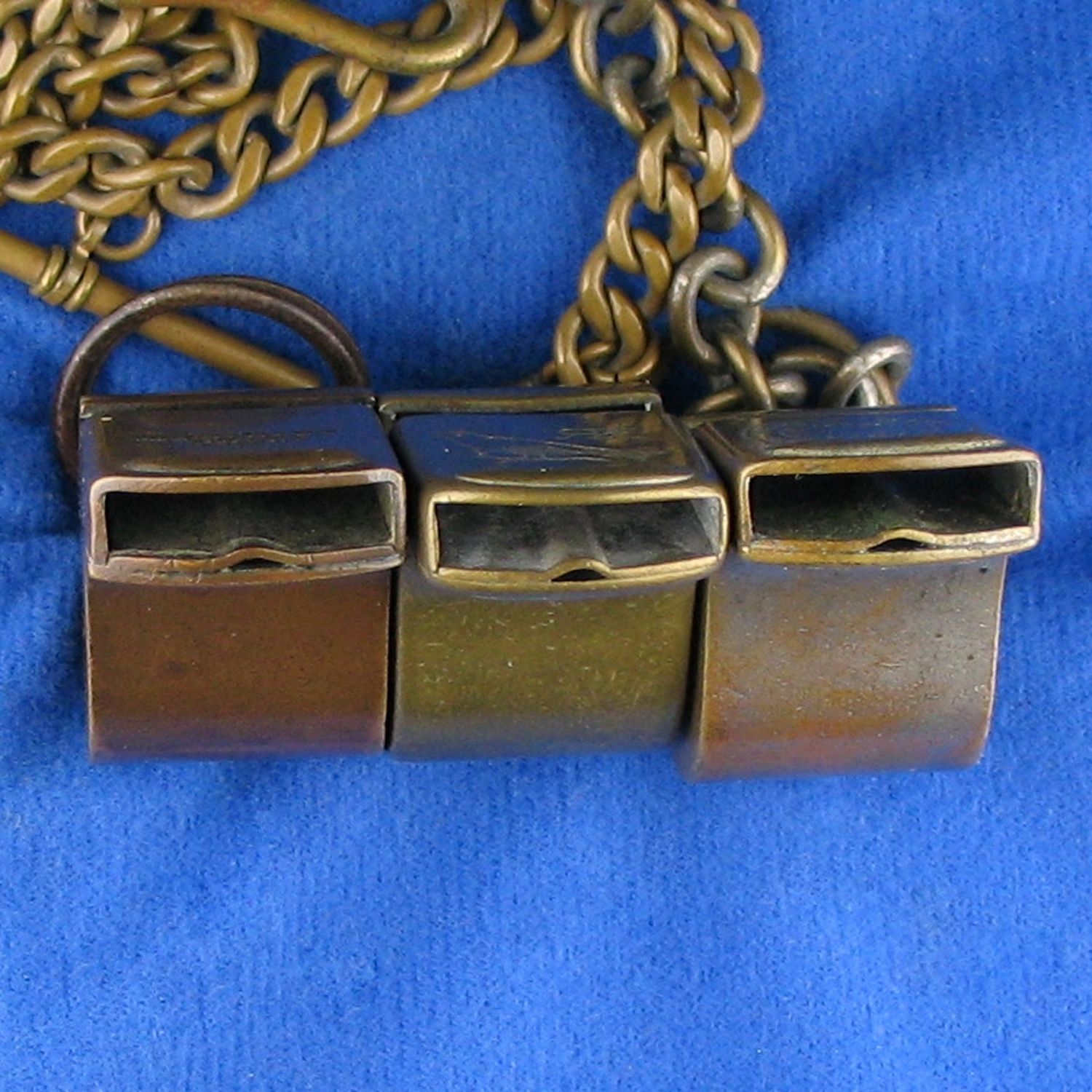
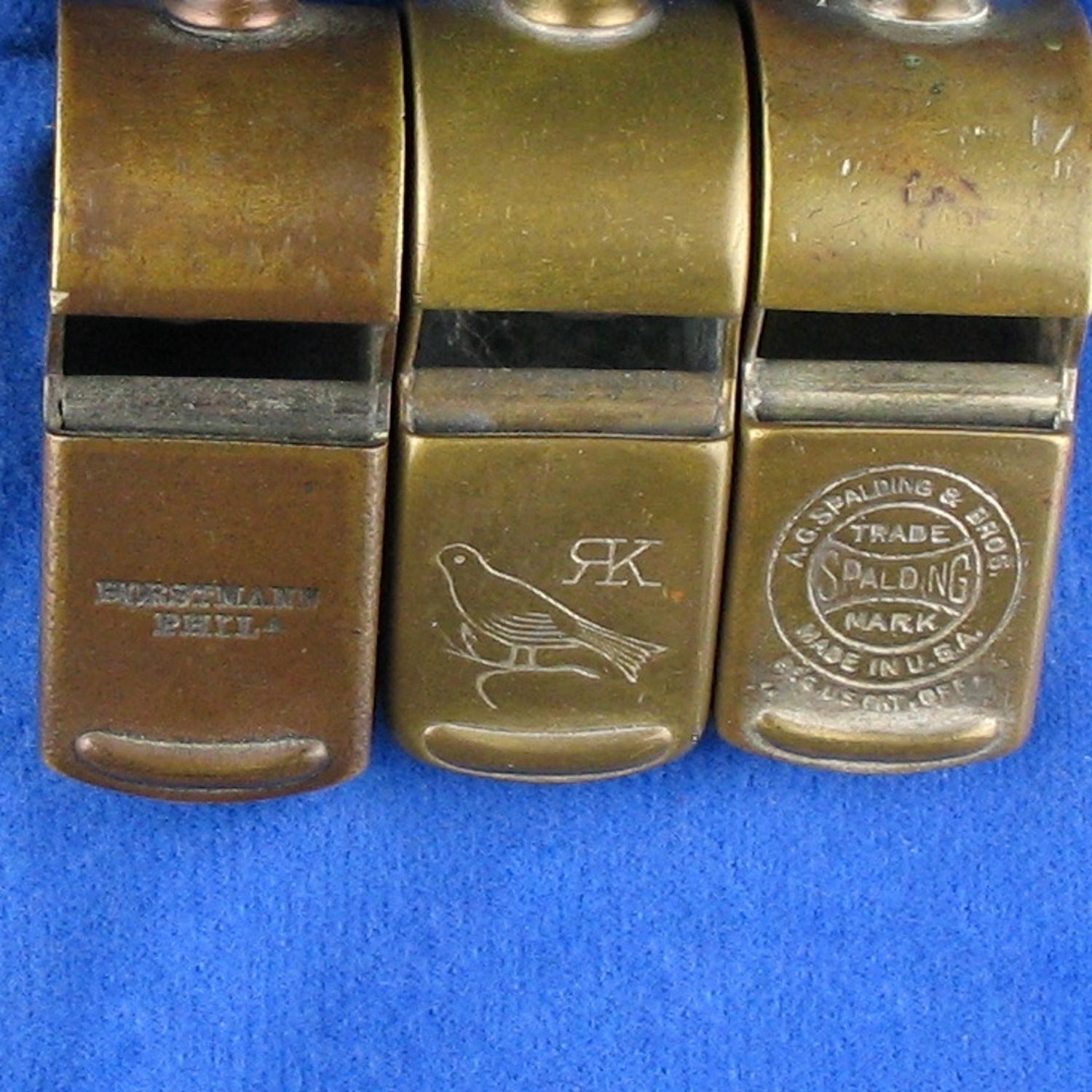
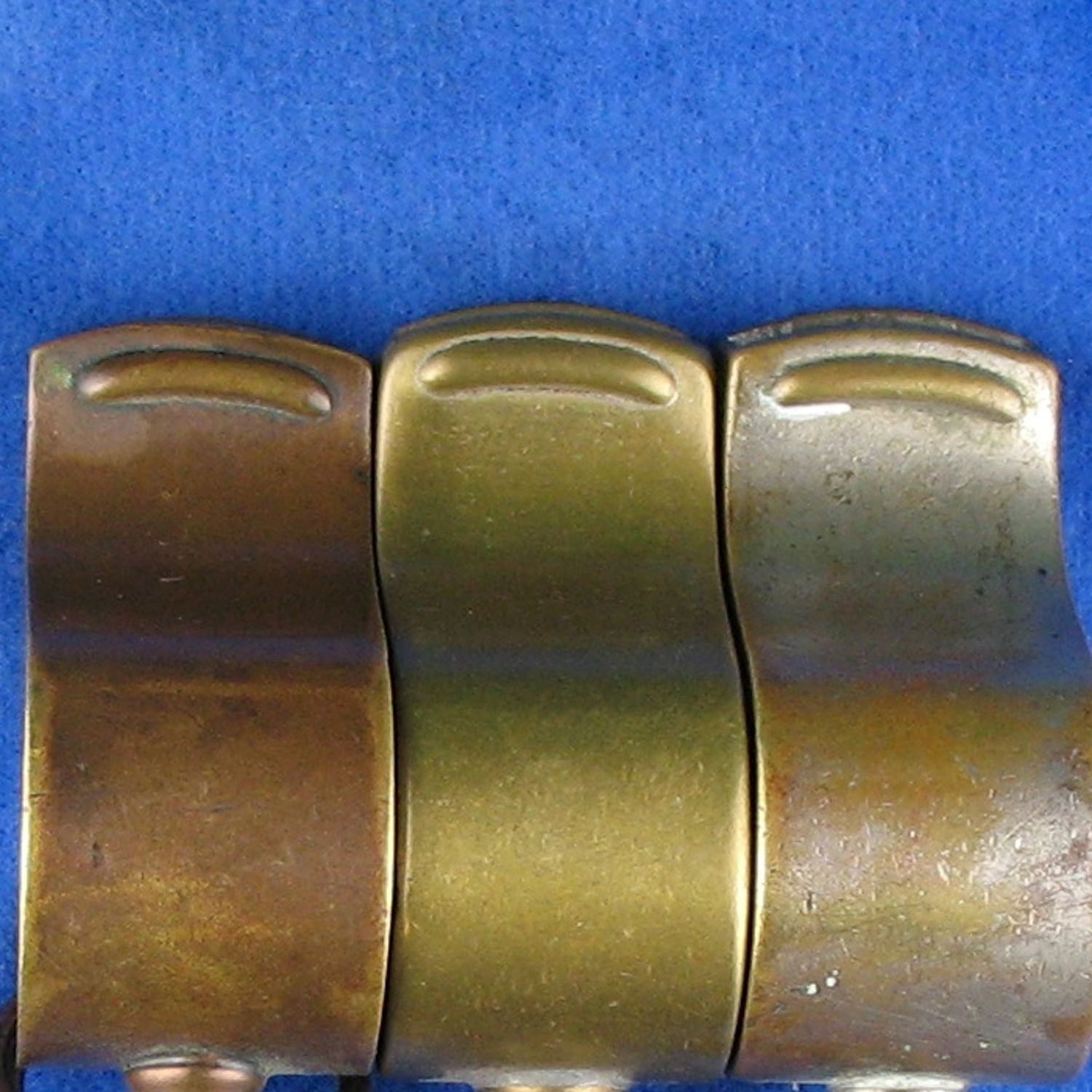
Here are three Arkay escargots, brass, plated brass and anodized copper finish.
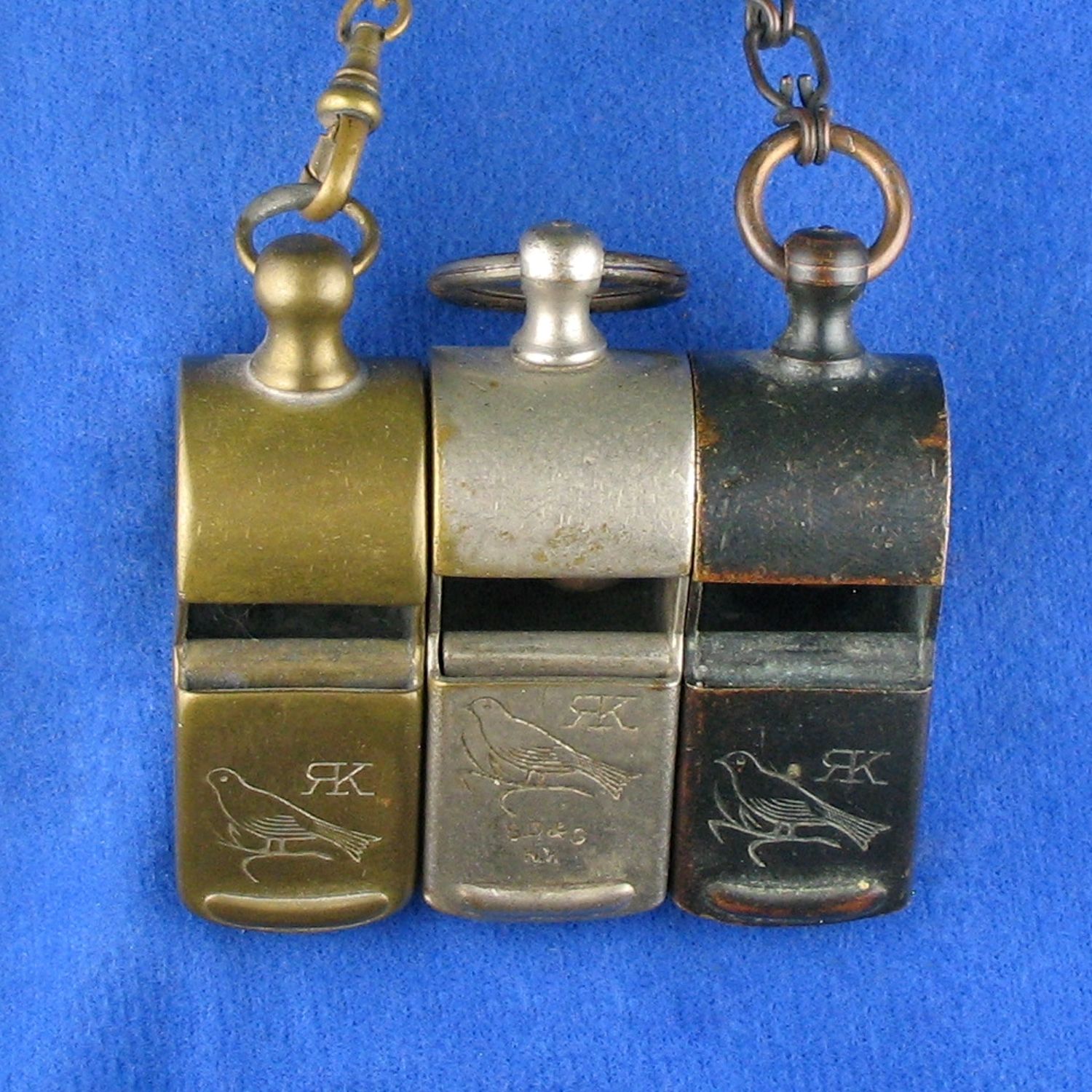
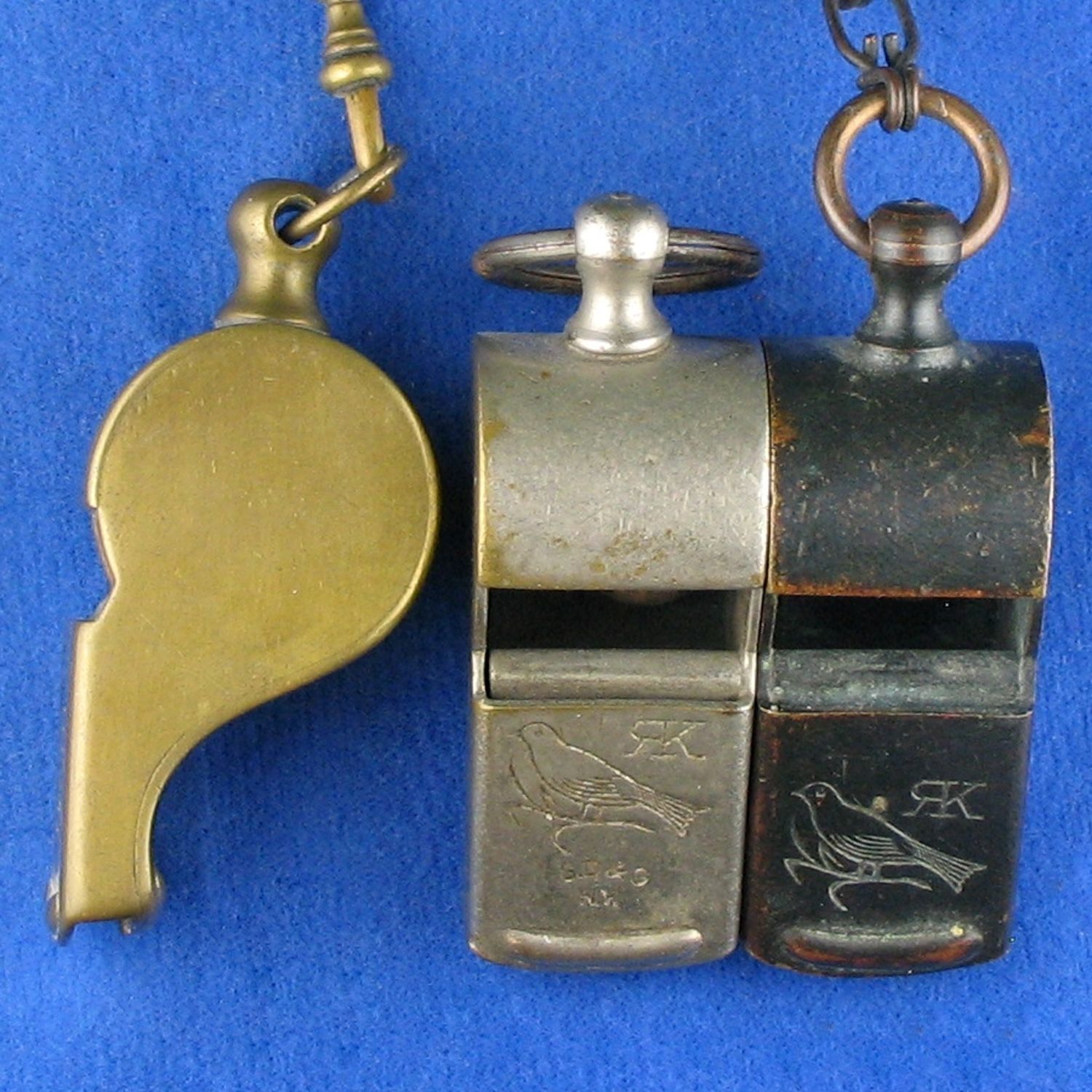
Lastly Spaulding matching whistles. Note the knop and window varies.
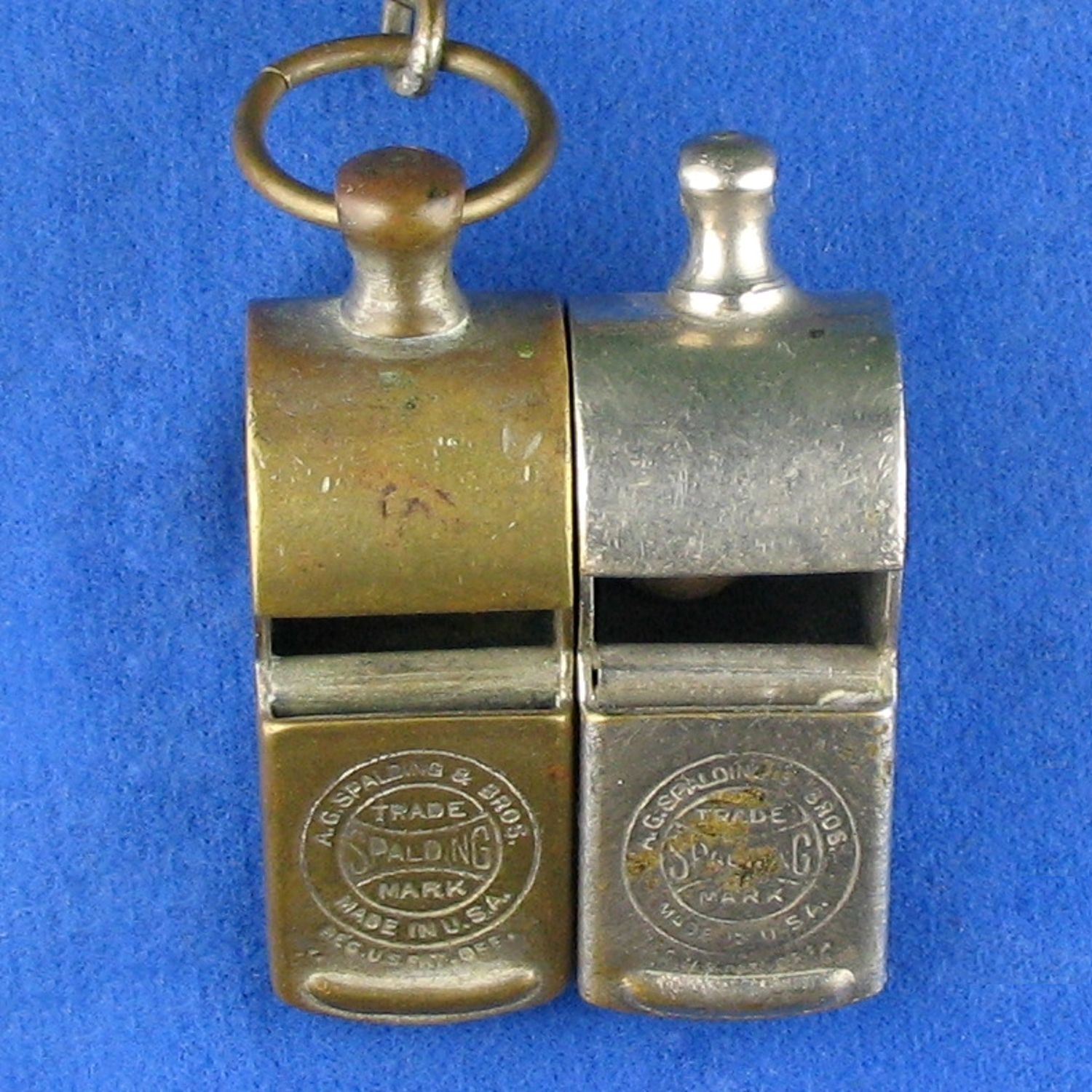
Compare to Spaulding’s by different manufacturing as seen in the knops, tooth grips ( and internal make up ).
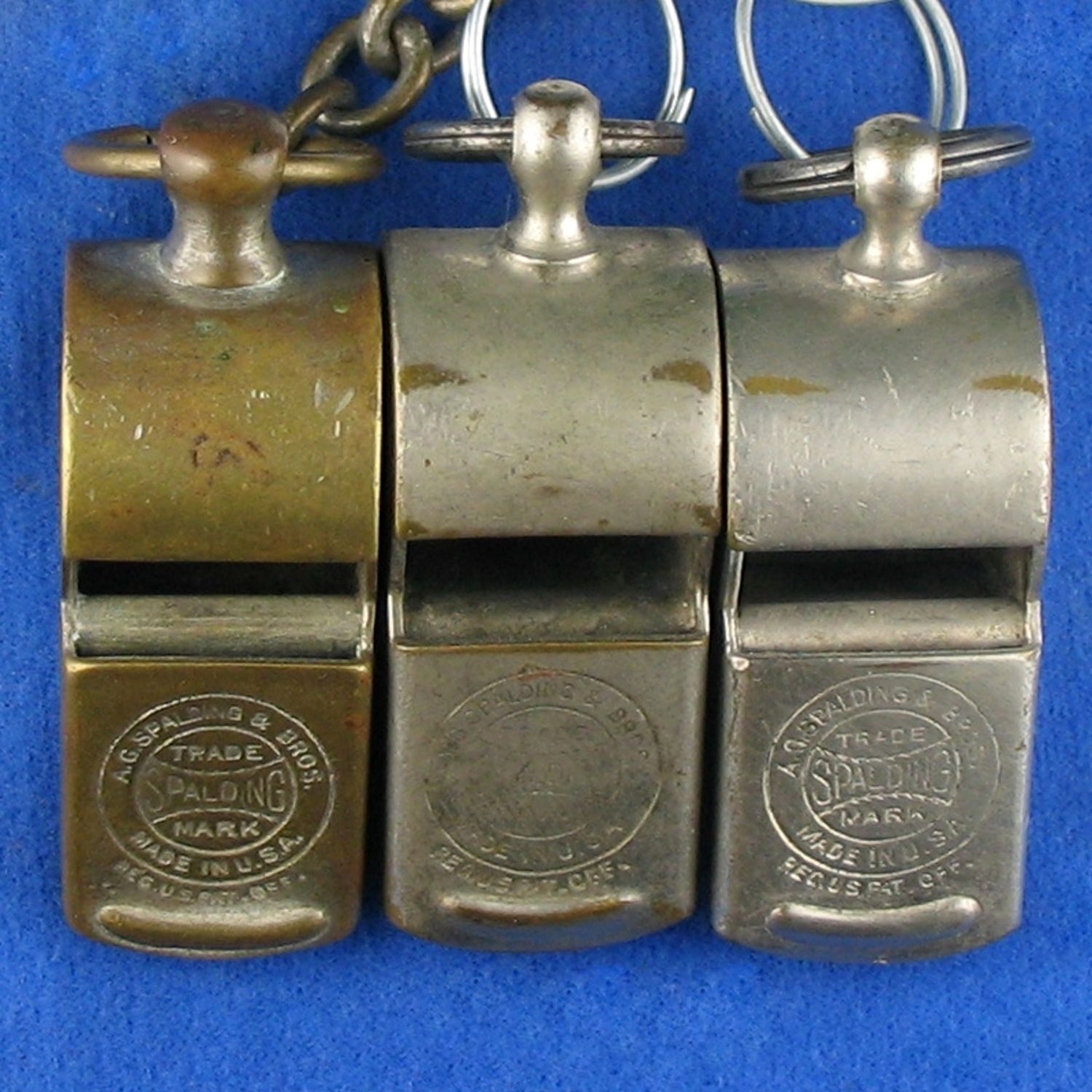
We close with a comparison of the three escargots by this manufacturer. We have compared tube shaped and escargot shaped whistles made by the same manufacturer. Spaulding did continue with escargots with other manufacturing as can be seen in the multitude of their stamps and especially spotted with the much smaller knops and different tongues, tooth grips, etc. These all seem to disappear by the WW11 period.
Therefore our assessment is that this complex of whistles would date from 1893 to post WW1, most likely post 1900. Assessing is sketchy and we continue to research the whistory of these. As always any insight, corrections, additional pictures are always welcome.
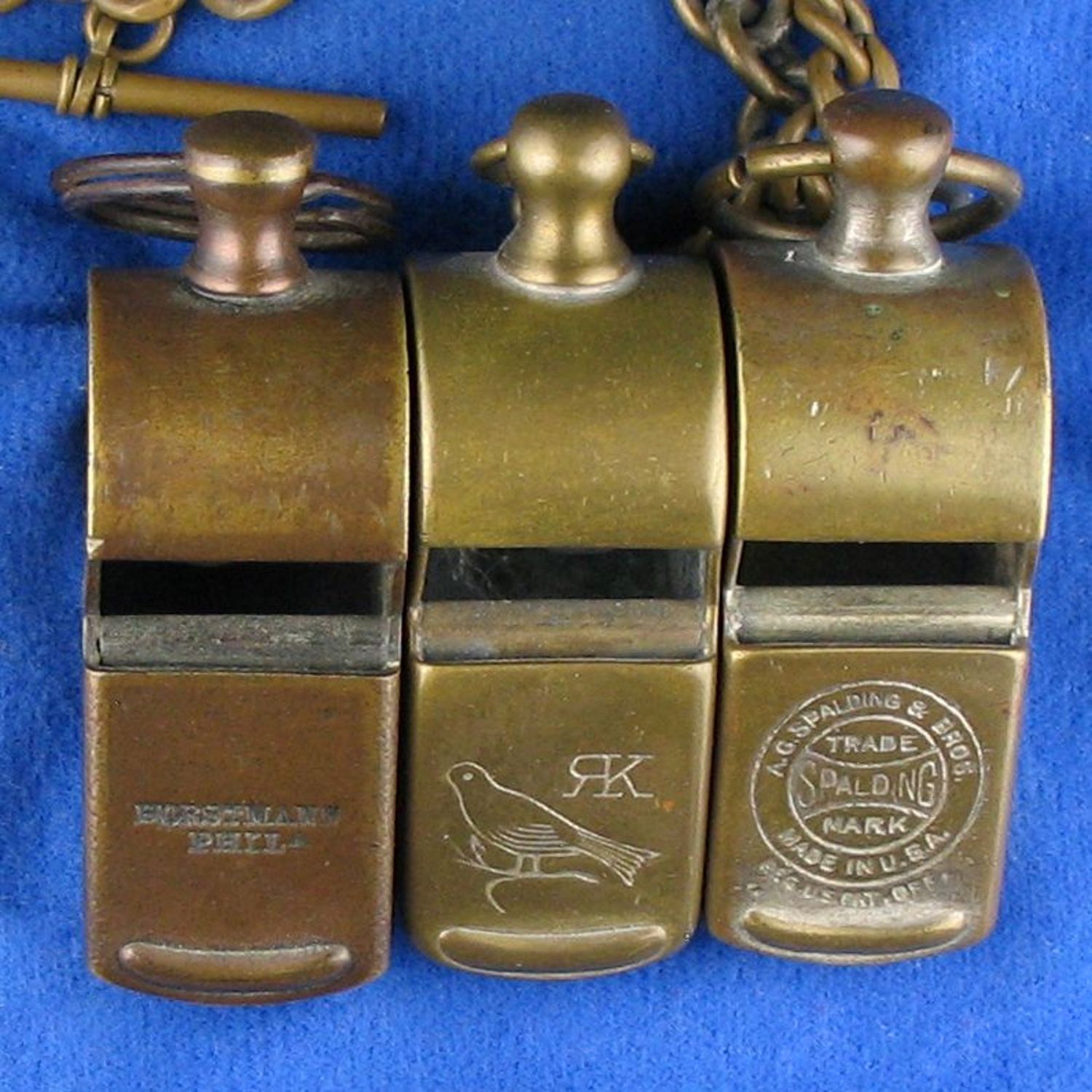
TWG
Posted August 5, 2019
Bibliography:
Workshop of the world
Union Army Uniforms and Insignia
of the American Civil War 1861-1865-Presented by Dr. Howard G. Lanham
A history of American manufactures, from 1608 to 1860: exhibiting …, Volume 2
By John Leander Bishop, Edwin Troxell Freedley, Edward Young
Edward Young & Co., 1864
Internet forums
Albert Spaulding in Chicago, Illinois in 1876









